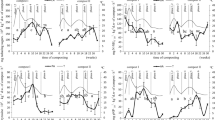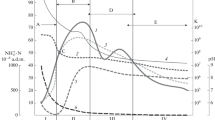Abstract
Seven mixtures from four organic residues—an aerobic sewage sludge, a city refuse, a peat residue, and a grape debris—were composted, and the changes undergone by their different carbon fractions during their composting and maturation were studied. In most cases a decrease in carbon fractions during the composting and maturation processes was observed. The extractable carbon, however, increased during maturation. Organic matter mineralization was greater in the composts with city refuse than in those with sewage sludge. The samples with peat residue showed the lowest decreases in carbon fractions. During maturation, an increase of humiclike fraction was observed, which was reflected by a decrease in the soluble carbon-precipitated carbon ratio at pH 2. Water-soluble carbon was the carbon fraction most easily degradable by microorganisms, and its amount correlated significantly with composting time in all the samples.
Similar content being viewed by others
Literature Cited
García, C., T. Hernández, and F. Costa. 1990. Phytotoxicity suppression in urban organic wastes.BioCycle 31:62–64.
García, C., T. Hernández, and F. Costa. 1991. The influence of composting on the fertilizing value of an aerobic sewage sludge.Plant and Soil (in press).
George T., and J. R. Felbeck. 1971. Structural hypotheses of soil humic acids.Soil Science 111:42–48.
Gray, K. R., K. Sherman, and Biddlestone. 1971. A review of composting—Part I.Process Biochemistry 5:32–36.
Inoko, A., K. Miyamatsu, and K. Sugahara. 1979. On some organic constituents of city refuse composts produced in Japan.Soil Science and Plant Nutrition 25:225–234.
Kaila, A. 1956. Determination of the degree of humification in peat samples.Maataloustieteellinen Aikakauskirja 28:18–30.
Kononova, M. M. 1966. Soil Organic Matter, 2nd ed. Pergamon Press, Oxford, 544 pp.
Levi-Minzi, R., R. Riffaldi, and A. Saviozzi. 1986. Organic matter and nutrients in fresh and mature farmyard manure.Agricultural Wastes 16:225–236.
Mitsuyo, F., A. Hirai, and H. Kubota. 1986. Effect of compost maturity on plant growth.Biocycle 27:58–61.
Roletto, E., R. Barberis, M. Consiglio, and R. Iodice. 1985. Chemical parameters for evaluating compost maturity.Biocycle 26:46–51.
Sugahara, K., and A. Inoko. 1981. Composition analysis of humus and characterization of humic acid obtained from city refuse compost.Soil Science and Plant Nutrition 27:213–224.
Thomann, C. 1963. Some observations on the extraction of soil humus. The sodium-pyrophosphate method.ORSTOM Cahiers Pédologie 3:43–72.
USDA (United States Salinity Laboratory Staff). 1954. Diagnosis and improvement of saline and alkali soils. Agricultural Handbook 60. Washington, DC.
Zucconi, F., A. Pera, M. Forte, and M. de Bertoldi. 1981. Evaluating toxicity of immature compost.Biocycle 22:54–57.
Author information
Authors and Affiliations
Rights and permissions
About this article
Cite this article
Garcia, C., Hernandez, T. & Costa, F. Changes in carbon fractions during composting and maturation of organic wastes. Environmental Management 15, 433–439 (1991). https://doi.org/10.1007/BF02393889
Issue Date:
DOI: https://doi.org/10.1007/BF02393889




